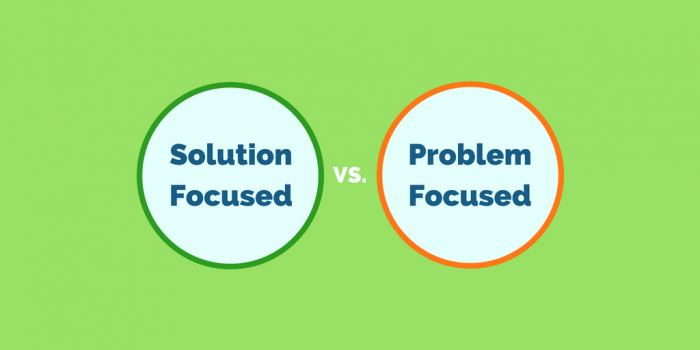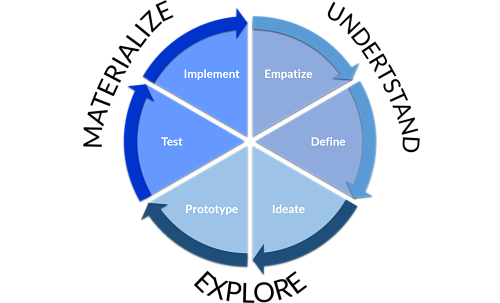What Is Design Thinking?
When you hear “design thinking” and you don’t know what it is, you’re probably thinking to yourself:
I do understand the words, but I don’t understand the phrase.
Let’s go step by step, and start with the definition of each of the words to get to the definition of design thinking.
Design means to create, fashion, execute, or construct according to plan; to conceive and plan out in the mind.
Thinking is the action of using one’s mind to produce thoughts, opinion, judgment.
And putting it all together, it gives:
Design Thinking is a method for practical, creative, and innovative resolution of problems.
Design thinking structures our thinking in a way that permits the creation of constructive results. It is a form of thinking that is solution-focused and user-centric rather than problem-focused.
“We spend a lot time designing the bridge, but not enough time thinking about the people who are crossing it.”
– Dr. Prabhjot Singh, Director of Systems Design at the Earth Institute
The term design thinking was first used in 1965 by L. Bruce Archer in his book “Systematic Method for Designers”.
The concept evolved and in the 1980s and 1990s the term design thinking was made famous by the not less famous Stanford DSchool where Rolf Faste taught “design thinking as a method of creative action”.

His colleague at Stanford DSchool, David M. Kelley, developed the concept even further when he founded IDEO. The declared mission of IDEO is to create positive impact through design. It uses the design thinking methodology to design products, services, environments, and digital experiences.
“The main tenet of design thinking is empathy for the people you’re trying to design for. Leadership is exactly the same thing – building empathy for the people that you’re entrusted to help.
– David Kelley, Founder of IDEO
How Does Design Thinking Work?
The design thinking process is an iterative set of steps that allow us to first understand the problem, examine the solution and materialize a constructive result.
This is how the design cycle looks like:

The design thinking process involves the following 6 steps
-
Empathize
-
Define
-
Ideate
-
Prototype
-
Test
-
Implement
Empathize
You start with the beginning: you want to understand what the REAL problem is. During the empathize step of the process you observe, ask questions, and reflect on what you learn.
You develop a sense of empathy with the users and their needs.
Define
In this second step, with the information you gathered in the previous step, you become aware of the problem. You start developing insights. And you define the problem.
The structure of your problem definition should be: user + needs + insights.
Ideate
During this phase, you generate ideas. You brainstorm.
Brainstorming implies suspending judgment and becoming as creative as possible (without caring about being realistic).
It’s ok to be a dreamer, a risk-taker, a wishful-thinker. The more ideas you generate the better it is.
This should be an exercise in unleashing your creative powers.
“Human-centered design is a philosophy, not a precise set of methods, but one that assumes that innovation should start by getting close to users and observing their activities.”
– Donald A. Norman, Co-founder of Nielsen Norman Group
Prototype
That’s when you become a little more realistic. Prototyping shouldn’t take a lot of time.
A prototype should be a rough representation of your thinking, developed just enough to help you convey your idea.
Don’t waste too much time in developing a prototype, fail early, fail fast, and fail forward.
Test
Now it’s time to take your prototype and test it in real life.
You start to collect feedback on your prototype, test what works, what doesn’t, what you can keep, and what you need to discard.
This is an iterative step. You prototype first, then you test your prototype, you gather feedback, then you go back and improve the prototype. You repeat this process until you can come up with a constructive result.
Implement
Your solution is ready to be put into practice. And because you took the time to understand the problem instead of directly jumping to a solution.
Where Can I Use Design Thinking?
Everywhere a little thinking is involved.
Everywhere a complex problem needs a constructive solution.
Here’s a good argument for using design thinking in your life, business, and everywhere where a little creative constructive solution to a complex problem is needed:
Rumour has it that even Airbnb used this method to ramp up its business (you already know the results).
Airbnb aside, design thinking can be used in business, marketing, social entrepreneurship, and everywhere a customer-centric complex problem needs to be solved.
Design thinking is used by creative leaders who seek to infuse innovation in the DNA of their organizations. Are you one of them?
The Books You Need to Read:
Tim Brown – Change by Design: How Design Thinking Transforms Organizations and Inspires Innovation
Tina Seelig – Insight Out: Get Ideas Out of Your Head and Into the World
Roger L. Martin – Design of Business: Why Design Thinking is the Next Competitive Advantage
David Kelley – Creative Confidence: Unleashing the Creative Potential Within Us All





